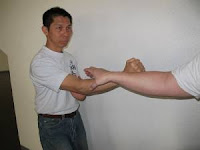Snake Crane Wing Chun is one of the oldest Wing Chun styles today . Kept in secret until recently this style still preserves original teachings and techniques of the first generation of masters and creators of the art . Being a family style , known to only handful of people over the years , style was preserved in its original form , kept from any outside influences . All techniques , concepts and principles are exactly the same as they were in 1850 , when the style was created in Red Boat opera company .
One of Snake Crane Wing Chun basic concepts is ‘snake reel and crane withstand’. Just as the snake suddenly attack and in the moment of contact curls around the victim completely disabling any movement in SCWC this concept is used in hand and leg techniques to stick and\or trap the opponents bridge hands and make their attacks or defense activities completely blocked. “Crane withstand “ represents the concept of resistance to the opponent’s violent and powerful attacks by the momentum built up on hand bridge or foot. This force is generated using the proper SCWC body structure and sent throughout the body to the bridges to meet and resist incoming force by neutralizing it several different ways . Sake Crane Wing Chun demonstrates both , the snake and crane motions in three hand forms . What is interesting , while morphologically we can clearly divide movements on snake movements and crane movements ,one movement can have snake or crane characteristics , which depends of the situation and the quality , characteristic and type of the force used for that particular movement .Of course this requires a lot of training and it is not a skill which beginners can completely understand .
One of Snake Crane Wing Chun basic concepts is ‘snake reel and crane withstand’. Just as the snake suddenly attack and in the moment of contact curls around the victim completely disabling any movement in SCWC this concept is used in hand and leg techniques to stick and\or trap the opponents bridge hands and make their attacks or defense activities completely blocked. “Crane withstand “ represents the concept of resistance to the opponent’s violent and powerful attacks by the momentum built up on hand bridge or foot. This force is generated using the proper SCWC body structure and sent throughout the body to the bridges to meet and resist incoming force by neutralizing it several different ways . Sake Crane Wing Chun demonstrates both , the snake and crane motions in three hand forms . What is interesting , while morphologically we can clearly divide movements on snake movements and crane movements ,one movement can have snake or crane characteristics , which depends of the situation and the quality , characteristic and type of the force used for that particular movement .Of course this requires a lot of training and it is not a skill which beginners can completely understand .
Like in most of the other Wing Chun styles ,
in Snake Crane Wing Chun is believed that moves come from the "Snake and
Crane competing to their best” 「蛇鶴爭暉」. What does really "Snake and Crane competing
to their best” mean? Snake and
crane movements have distinct characteristic and are built upon specific
concepts and principles , physical ,that determine specific ways of force
generation and structural alignment , and fighting concepts and principles ,
that determine the technology of using the specific movement in a fighting
situation . Snake Crane Wing Chun
combines the best features of snake and crane movements into a simple , yet
extremely efficient and effective fighting style . Morphologically , snake techniques are Tan Sau,
Lan Sau, Fok Sau , LapSau etc, while the crane techniques are Ton Kiu, Guan Sau and Bong Sau etc. The following briefly describes several
techniques of the snake and crane motions of Snake Crane Wing Chun.
Snake’s hand techniques:
Tan Sau(Palm
side up): The”
palm up block “(snake head reversed) moves from the side of waist to the center
of the body. Then moves and extends
outwards to block the opponent’s bridge along the centerline.
Lan Sau(Blocking
hand): The palm like a snake head moves from the
side of the waist to the centerline of the body and extends outwards to block
directly the opponent’s bridge hand along the centerline.
Fok Sau(Lying
hand): the palm moves out from the centerline, such
as the snake head going quickly outwards,
blocking and lying on the opponent’s bridge hand.
Lap Sau(Grabbing
hand): Tan Sau ,when the palm is turned around or LanSau
can be easily changed into a lap sau. The fingers are open and they pointing
forward whiled the thumb pointing to the
ground reminding on a snake’s open mouth. Fingers
grab and hold the target, and then pull back.
This technique look just like the snake head attacking the victim with wildly open mouth while
fingertips looks like a fangs. After biting the victim snake will pull back her
body quickly , that’s why the last
motion of the techniques is pulling back.
Crane’s hand techniques:
Ton Kiu(Swallow
bridge hand): Upper arm is ideally parallel with the ground
, but necessarily , and forearm and arm make 135 degrees angle . This block is
usually used to cover upper gates.
Guan Sau(Cultivating hand): Lower block usually used to protect lower gates from various attacks. It is performed just like a crane’s wing lowered down in a sweeping movement ,”cleaning “ and “picking up” everything that coms toward the lower gates

Bong Sau(Crane’s wing hand): It is performed by rolling the forearm out and the raising the elbow up, the fingertips are moving forward toward the center of the opponent . Bong sau can be performed to cover lower, middle and upper gates.














Нема коментара:
Постави коментар